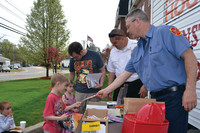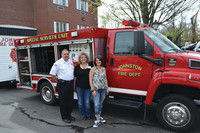

Carbon monoxide is a silent killer, and on average the Johnston Fire Department responds to approximately five carbon monoxide related calls each week. But thanks to a local carbon monoxide detector giveaway program, more Johnston families now have an extra level of protection against a possible tragedy.
Last Saturday, the Johnston Fire Department and the Johnston Firefighters Local 1950, the Johnston Home Depot, The Bridge at Cherry Hill Assisted Living Community and the Cherry Hill Manor Nursing and Rehabilitation Center partnered together to give out 120 free carbon monoxide alarms to town residents.
“This is to raise awareness of carbon monoxide detectors and to provide one to those that may not have the device,” said Lorraine DiLorenzo, marketing director at Cherry Hill Manor. “We wanted to give these away because we’re a staple in the community and show just how much we care.”
In February, a family of five in nearby Smithfield suffered carbon monoxide poisoning. A mother, father and three children under the age of 11 were taken to area hospitals to be treated. According to reports, their home did not have any functioning carbon monoxide detectors. Unfortunately, the mother of the family, Kristin LaTour, 47, later succumbed from the poisoning. That calamity, and others like it, inspired the giveaway program.
“We’re trying to help the community. We really don’t want to see something like that happen here,” said Jennifer Burns, sales director at The Bridge at Cherry Hill.
Johnston Fire Department Battalion Chief Thomas Marcello, who serves as fire marshal, underscored how vital the devices are for each and every Johnston home.
“It’s absolutely 100 percent important to install these for life safety. Life safety comes first in the town of Johnston,” he said.
According to Marcello, the department responds to calls where alarms are activated, whether there’s an actual emergency or a detector that needs its batteries changed. He said sometimes residents are not aware of what’s going on when the alarm sounds and call the fire department with their concerns.
“That is perfectly okay with us,” he said.
Residents who visited the fire department’s display area, which was set up in the parking lot of Cherry Hill Manor, only needed to provide proof of Johnston residency to obtain the alarm, which retailed for about $20 per device.
“I think I should have had one a long time ago. I didn’t have one, I was just being careless,” said Gabrielle Laplante as she picked up her device. “I didn’t think I needed one because I don’t have gas in my house. But I went online and I checked into it and you really should have it.”
Typically, carbon monoxide is produced by non-electric, fuel fired furnaces and gas-powered devices such as water heaters, stoves and dryers. Automobiles in garages, fireplaces, grills and yard equipment can also emit the gas.
Battalion Chief Marcello provided installation advice to those who attended the event, and recommended installing the device in bedroom areas or outside of bedrooms in the hallway. Devices installed in a garage or near a boiler may not be heard by someone who is asleep. In addition to providing advice, the department’s Fire Safety House was on scene to give residents fire and smoke educational material for the family.
“If you have a detector, it will usually go off with monoxide levels anywhere from five parts per million to ten parts per million. If you don’t have a detector, you may start feeling ill if levels get above 50 to 100 parts per million in a house,” he said. “You’ll start feeling dizzy, you might have a constant sickness of not feeling well, sweating and vomiting, depending on how high the levels are. Eventually, people will pass out depending on high the level goes.”
Marcello explained that, if firefighters are called to a residence, they’ll go in and check the stove and boiler area of the home utilizing meters on their fire apparatus, and if there’s nothing found they will tell homeowners that the alarm was a faulty detector.
“We check the dates on the detector, which are only good for seven to 10 years depending on the manufacturer,” he said. “Sometimes its just time to change them.”
Firefighters will respond to the scene with personal protective equipment and self-contained breathing apparatus and will wear that into a home’s boiler area along with a monitor that will read any natural gas leakage, carbon monoxide and oxygen levels in the house, so if the oxygen level is low they’ll know that there’s something wrong.
The fire department recommends the safe use and proper installation of appliances that burn fuel. Carbon monoxide detectors add an extra level of protection, but are not a substitute for safe use of equipment. They also recommend having heating equipment inspected each year and to know the proper use and maintenance of household cooking equipment.
A limited number of additional carbon monoxide detectors are still available for those who were unable to attend the giveaway. They may be found at the Atwood Avenue fire station 351-1600, at The Bridge at Cherry Hill 233-2880, or at Cherry Hill Manor 231-3102.
“We really want to help protect the community, and this giveaway is a great way to do that,” said Jennifer Burns.
Comments
No comments on this item Please log in to comment by clicking here